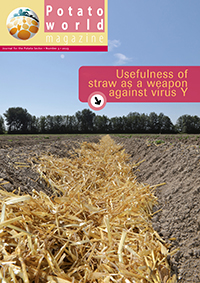Already a subscriber? Activate your premium account

Potatoworld Magazine

In December last year – among other countries – Wageningen colleagues and I visited India and were confronted with – for me that is – almost unprecedented occurrence of black scurf causing considerable damage to potato crops. In Punjab the seed potato state in North-Western India we were shown fields with foliar symptoms as shown in the picture below.
Some fields had severe symptoms and clearly had reduced yields as the foliage did not fully cover the soil so not all solar radiation was intercepted. The farmers had no clue as to what caused this phenomenon. Upon further inspection many basal parts of the stem showed brown lesions and when digging up the tubers many were deformed as shown in the picture. We then were sure to be dealing with the disease black scurf caused by the fungus Rhizoctonia solani. Looking at many more plants and digging up tubers we detected the complete range of symptoms that the disease shows: beside the leaf curling and lower stem lesions a large proportion of the plants showed many small superficially growing tubers. This is caused by dying tips of the stolon that then bifurcate. If this process is repeated a few times there are numerous stolon tips and when they finally form tubers there are many dozens of them. Reason why in the Netherlands the disease is called “small potato disease”. When Rhizoctonia blocks stem vessels transport of photosynthetic products to below ground is hampered and areal tubers are formed. Occasionally we found white mycelium formed at the base of the stem where sexually reproduced spores are formed. When digging up mother tubers of missing plants often sprouts ad not emerged because the tips were killed and new sprouts formed that underwent the same problem. In February this year – after harvest of the seed crops – we went back to Punjab where growers were grading the crops and preparing for storage in cold stores before transporting them over longs distances to far away potato areas such as West Bengal, 2000 km by road or rail. One grower was grading and his workers were removing a large proportion of the crop – well over twenty-five percent – due to misshapen tubers showing scab like symptoms in typical squares, cracks with less sharp edges than growth cracks and fully deformed tubers without eyes: blind tubers. For one reason or another the typical black scurf sclerotia were not overly present.

Three weeks later when in Zimbabwe a seed potato grower in a special seed potato quarantine reserve in the mountains close to Mozambique wanted to have my views on what he called a ‘silent killer’. “Rhizoctonia you mean?” I said, whereupon he looked at me in surprise nodding affirmatively. Many of his seed potatoes showed deformations and typical black scurf sclerotia but he knew the disease and what to do against this underestimated killer. For additional disease description the book “Potato diseases” by A Mulder and L J Turkensteen and for management strategies the article by L. Tsror “Biology, Epidemiology and Management of Rhizoctonia solani on Potato” in the Journal of Phytopathology (2010) offer excellent further reading. Adequate chemical control by treating seed tubers exists. Special attention is needed when summer crops are planted in a cold spring or winter crops in a hot autumn as then the fungus outgrows the slow growing sprout making it especially vulnerable. ●
Anton Haverkort
anton.haverkort@wur.nl
Events
©2015 - 2024 Potatoworld | Webdesign and realisation COMMPRO